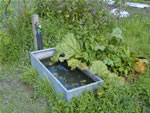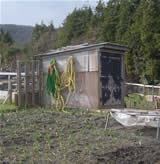April 2008 fruit and vegetable growing on allotments and vegetable gardens
April 1st 2008
Important day - potates planted. The potatoes had been chitting since December. Place them in egg boxes in a cool room with plenty of light. It's interesting to see how they shoot - there is definitely a right and wrong way up. You will only know which is the right way up after a few weeks. Ones shooting from underneath should be turned the right way up.
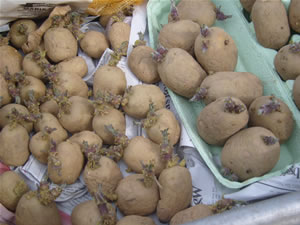
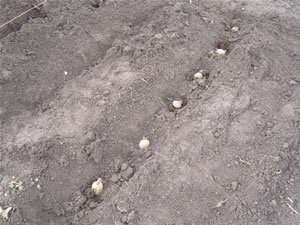
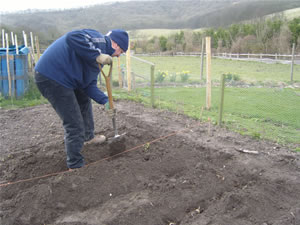
APRIL ARTICLE
Growing Vegetables On A Small Plot
There are three basic growing techniques that you can use to make the most of your space. These are known as intercropping, catch cropping and successional sowing.
The latter two will mean that you extend the cropping season instead of harvesting your crop all at once. You will also make use of the available space and increase your yields. All you need to do is carefully plan which crops to sow and when.
Intercropping increases productivity and also helps to keep the weeds down. Intercropping means that you plant a fast growing crop, such as carrots, radishes and lettuce between main crops that are slower growing.
These include vegetables such as cabbages, peas and potatoes. Intercropping involves harvesting the quicker growing crop first before the slower growing one achieves total foliage cover of the soil and shades out the area.
A good example of intercropping is to grow a crop of spring onions or lettuce between tomatoes. Spinach or radishes can easily be planted between sweetcorn or cabbages.
Intercropping can also be used to increase productivity. It ensures that no space is left unused and makes the most efficient use of light, nutrients and moisture. It will also reduce the amount of weeds in the vegetable patch by maintaining a continuous plant canopy over the soil.
You could also combine the benefits of a green manure with a crop. This can be useful in the case of winter crops because the green manure doubles up as a cover crop, protecting the soil from erosion and leaching as well as stabilizing soil temperatures.
If leguminous green manure is planted in late summer or early autumn in a bed along with leafy crops such as Brussels sprouts, it can provide nitrogen throughout the remaining growing season. It will also provide a boost for early crops that will be planted out after the green manure crop has been dug into the soil. While intercropping requires careful planning, it can increase the productivity of even a relatively small vegetable plot.
Catch cropping is the technique where fast growing vegetables such as radishes and lettuce are planted into an area that has just been cropped and has a space to be used before the next crop is planted. The sowing of the catch crops can be done in between the main ones or after harvesting at the end of the season. It is important to know how long a crop takes to mature when planning catch cropping, so that you don't sow anything that takes too long to mature in between the main crops.
Fast maturing vegetables are often marketed at the impatient grower who demands speed over quantity. You can have the best of both worlds - if you sow quick growing radishes among rows of slower growing parsnips the radishes will mark out the position of the slow to germinate roots before you see them and you can weed around them without causing damage.
Successional sowing means sowing the seeds of fast maturing vegetables at regular intervals several times during the growing season. This will ensure that you have a continuous supply of crops such as lettuces, carrots and spinach throughout the season.
Successional sowing is also useful where crops were sown directly outdoors early in the season where they may be prone to frost damage. Early crops such a lettuce and radish can be sown under the cover of a cloche, where they will begin to develop earlier than would otherwise be the case.
Subsequent sowings outdoors will mature later and thus extending the growing season.
http://www.gardeningdelight.co.uk contains tips for the gardener. There is advice on the ornamental garden, borders, plants, kitchen garden, organic garden, vegetable growing, organic gardening Article Source: http://EzineArticles.com/?expert=Marion_Aston
